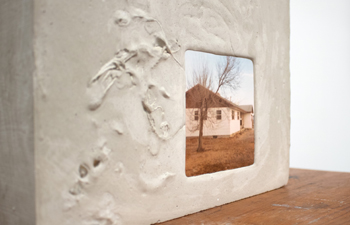
SXU Gallery Presents "Prairie Poetics"

Saint Xavier University (SXU) will host "Prairie Poetics," the work of artists Anne Skaug and Katie B. H. Wolff, who delve into the complexities of connection, place, lineage, and grief, through February 24. Rooted in found kinship, shared geography and uncanny origins, the installation is a material reflection of the conversations between Skaug and Wolff contemplating experiences that meet and diverge.
The artists use concrete, fibers, photographs, and found objects, through which portals are created, memories are embedded in cloth, landscapes transcend time, and in every absence is a presence. Each work exists within an unfolding archive of the topographies of grief, incarnation of internal landscapes, and longing to hold with tenderness the tension of one's inheritance.
Skaug and Wolff are a collaborative artist team who have been unofficially working together since they met during college. Their work is interdisciplinary, primarily employing sculpture, fibers, and photography, and they have always loved making art.
"My mom will often tell the story of asking me what I wanted to be when I grew up when I was about four years old, and I simply replied, 'an artist.' For me, making art is a way of understanding both the world and myself, which I accomplish through a combination of materials hinged on inherent physical qualities as well as cultural associations, creating an ecosystem of understanding as each work 'speaks' to one another," said Wolff.
"I regularly drew on the walls, my homework and my body. My family supported and nourished my interest in the visual arts. I primarily worked in 2D media until 2020, when I was introduced to installation art. From there, my practice exploded with interdisciplinary energy," added Skaug.
Skaug and Wolff met at Black Hills State University in 2019. During one semester, their schedules aligned to share every single class together, where they were astonished to discover they led "parallel lives."
Each artist has one parent that hails from Bergen, Noway, and one parent that originates from the tiny farming community of Hettinger, North Dakota, with both familial farms lying on the borders of North and South Dakota, where their ancestors settled in the 1800s. They were both also devastated by the loss of a parent in early adolescence, and their separate yet similar experiences of loss fostered an immediate understanding and kinship between the two.
"Our collaboration developed first and foremost out of our friendship and mutual love for making art. It also unfolded from a shared desire to process grief in a way that was productive in the most literal sense of the word. The physical work is the product of thinking, talking, and processing through sensation and story. There is an abundance of silent understanding between the two of us," said Wolff.
"When it comes to making [art], the two of us approach material quite differently, and this is the very success of our collaboration: difference in process in tandem with an unwavering alignment in concept," added Skaug.
The artists spoke about their work at a presentation and reception at SXU on January 24. They are thrilled to have their work exhibited in a university, the setting they found their first community of artists. Through the affirmation of that community, they were able to give themselves permission to pursue art in an intentional way.
"Displaying 'Prairie Poetics' at SXU is a heartening full-circle moment for us, and we hope it encourages the artists who view it to pursue their most honest work," said Wolff.
The SXU Gallery is open Monday, Wednesday and Friday from 10 a.m. to 5 p.m., Tuesday and Thursday from 11 a.m. to 5 p.m., and Saturday from 11 a.m. to 2 p.m. For more information, contact the Gallery at 773-298-3081.
Artist's Statement: Important Context for "I Lay on the Earth to Remember the Touch of Your Skin"
to hold the tension of one’s inheritance with tenderness / by Katie BH Wolff
The referenced landscape of "I Lay on the Earth to Remember the Touch of Your Skin" is the prairie along the borders of what is today known as North Dakota and South Dakota, previously known as part of what was Dakota Territory. These lands are indigenous to the Očhéthi Šakówin, People of the Seven Council Fires, the Lakota, Dakota, and Nakota people as well as the Cheyenne, Apsáalooke, and Kiowa.
We acknowledge that the history of this land dates back millennia before our white settler ancestors arrived and displaced thousands of Indigenous people as part of a government-sanctioned genocide and white supremacy project. As the descendants of settlers, we are aware of this history and our being tethered to it, though attempts at its erasure are pervasive and unrelenting.
It is our responsibility to learn and understand this land's history through Indigenous scholarship and perspectives as we continue our creative research and studio practices. We recognize our complicated relationship to this landscape, and that our existence is only possible because of the violence that came before us.
Our shared geography of this prairie plays a central role in our work and is in direct relationship to our parallel losses of a parent in childhood and adolescence. Layers of grief shroud this landscape, and both are felt deeply.
We understand our work as a material poetics attempting to hold the tension that exists in the fine line of a chasm situated between grief and joy. This landscape both carries the history of the most painful experiences of our lives and, in the truest nature of paradox, brings the deepest sense of safety, offering a physical closeness to our lost parents that exists nowhere else.
To inherit is to receive, to derive, to be left with. This work sits as an attempt to look at our inheritance–with all of its contradictions–and hold it with tenderness.

